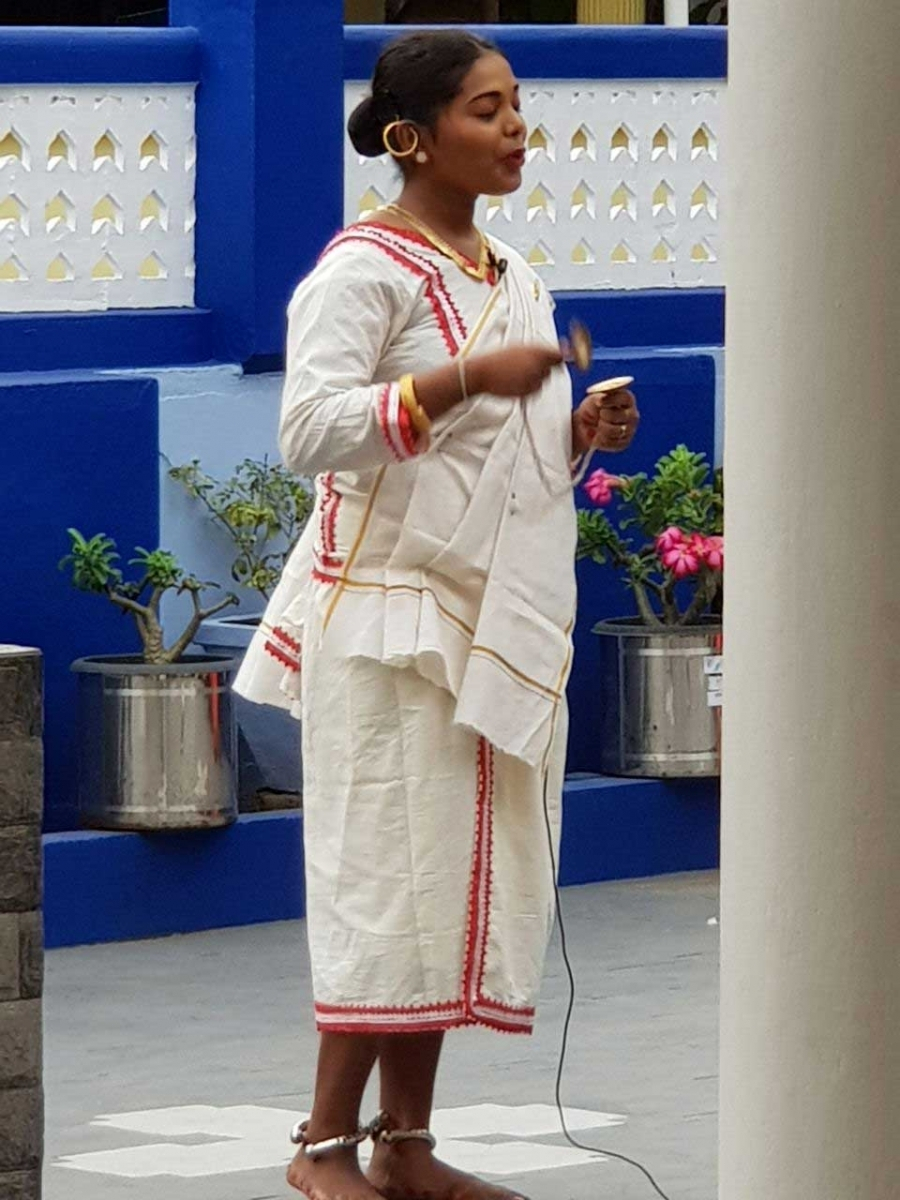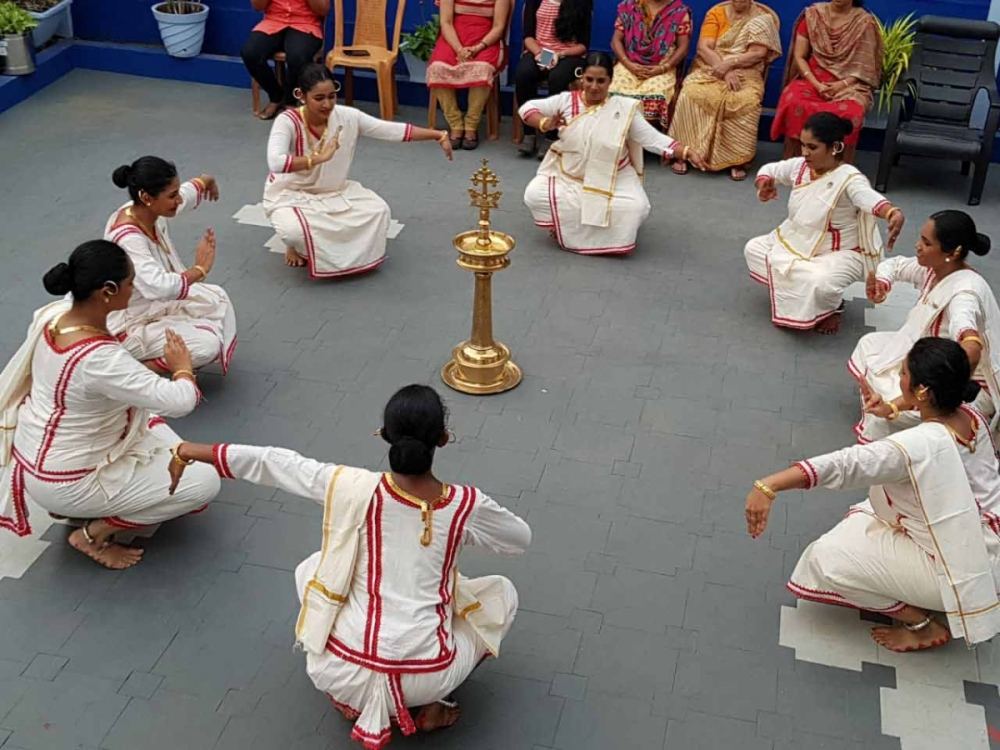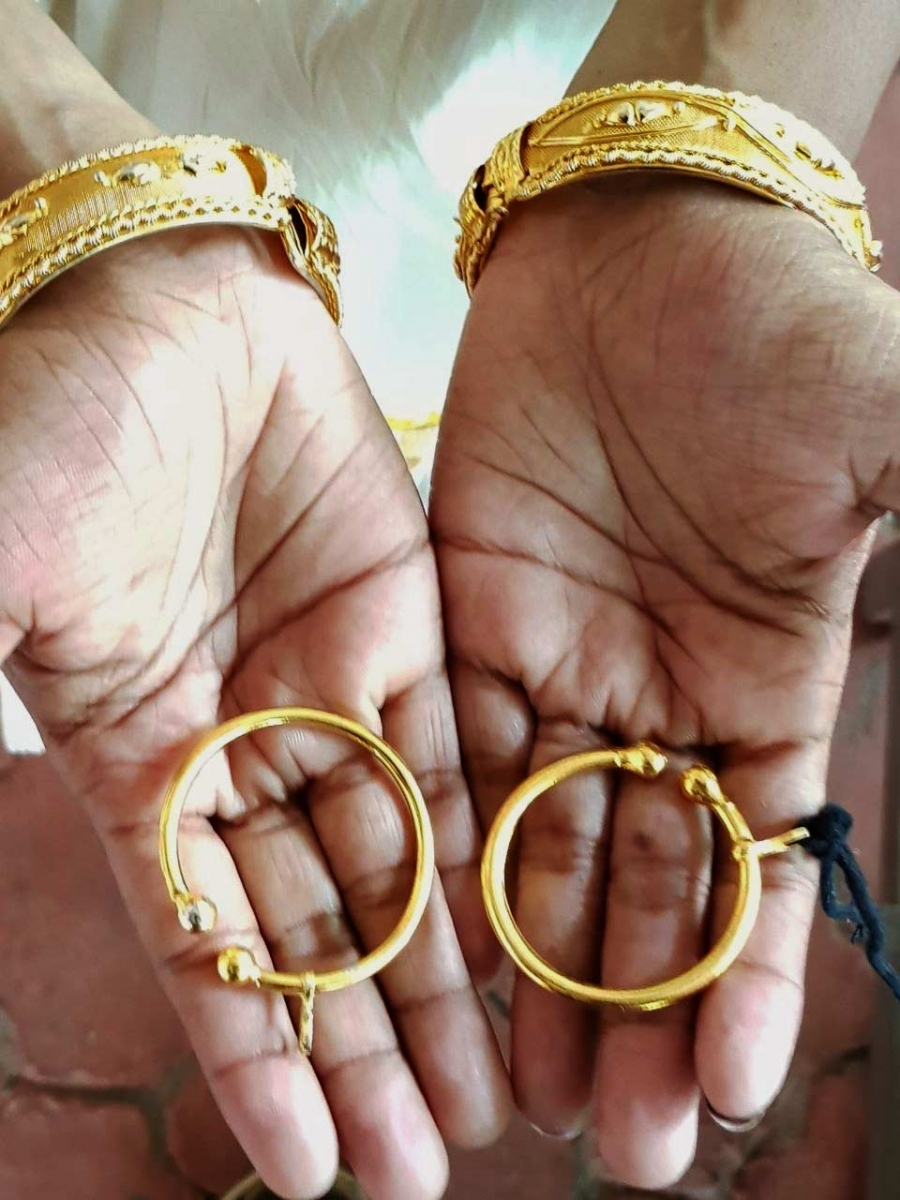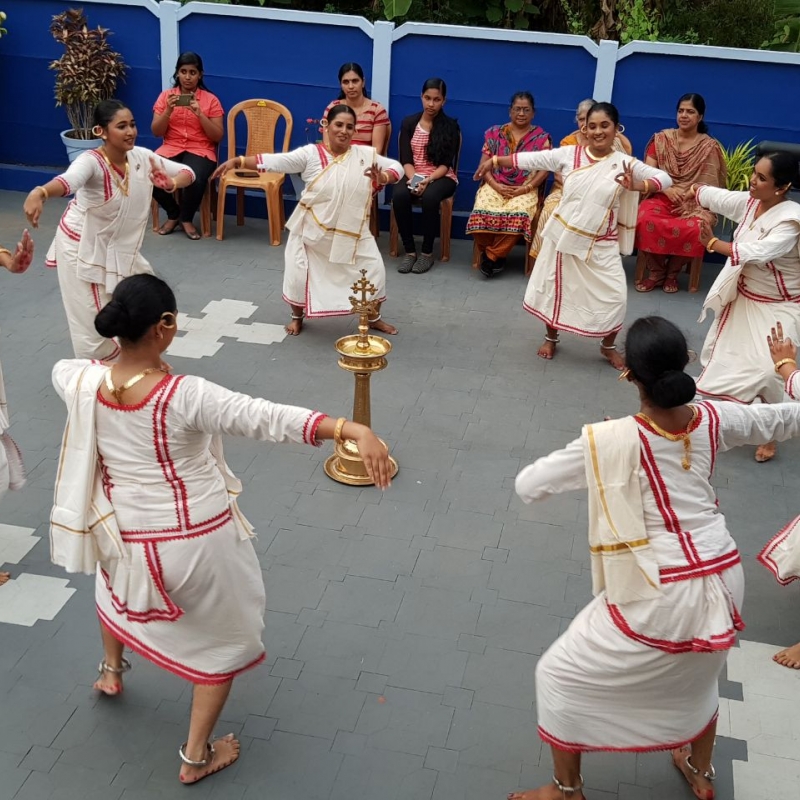The rituals and customs of the Christian community, which are in synthesis with the cultural traditions of Kerala, have facets inseparably interwoven with Hindu culture. For example, similar to the thulasithara (an elevated platform on which basil is planted) in a Hindu home, there are kurishutharas (elevated platforms with a cross) in Christian households. It is around this kurishuthara that, during the dance performance Margamkali, the dancers sing and dance in a circle.
Margamkali is a dance form performed by 12 men representing the 12 disciples of Christ. It is a ritual art form performed by men on the occasion of the Christian days of celebration, and on eve of weddings, with the performances continuing till dawn. Until recently, during festivities of the Syrian Christians, both Margamkali and Parichamuttukali (a martial dance form of Kerala) were performed. The first research paper on Margamkali was published by the eminent expert Chummar Choondal, a folk performance instructor, and the head of the Department of Malayalam at St. Thomas College, Thrissur. The dance form has gathered some visibility only recently.
The Bible and Dance
The Old and the New Testaments of the Bible are often found to mention dance. The Old Testament refers to dance as a means to boundless joy, where the life of the Jewish people is described.
The Jews danced on the holy day of Sabbath. According to the holy book, God spent six days to create the world, and on the seventh day, He rested. He blessed and sanctified the seventh day; as signified by the Sabbath Saturday. The people of Israel would hold processions and dance before sunset on Friday to welcome Sabbath. And then on Saturday evening, they ended Sabbath with dance again. On the day of the Sabbath, men would go to the synagogue, and women would gather at any one of the houses to dance, while the young would dance in the courtyard of the synagogue in the afternoon.
Dance was considered by the Jews to be like a prayer to the Creator. On the holy day of Simhat Torah, Jews would hold a procession with the holy book in their hands. The Rabbi (Jewish teacher/leader) would dance at the end of the procession. The watching laity would sing and clap to this dance. It is believed that the prophets made their prophecies while dancing and playing musical instruments.
Dance, which was a means of relaxation and entertainment, was used by early human beings as a form of worship. It was an art form they knew well and the habit of dancing on every occasion became an integral part of their lives. “I will rebuild you, my virgin Israel. You will again be happy and dance merrily with your tambourines”, says Prophet Jeremiah in the Old Testament (Jeremiah 31:4).
When King Saul came back to Israel, triumphant, after the young David had slain Goliath, the women of the city danced in abandon to the music of tambourines and other instruments (1 Samuel 18:16). There are mentions in the Old Testament about Jewish people singing and dancing to celebrate victories in battles, and every time they received God’s blessings.
The Bible describes Maria, sister of Prophet Aaron, playing the tambourine and dancing with other women, rejoicing the blessings of God; who protects them while they are crossing the Red Sea to escape the Pharaoh’s yoke of slavery.
During the Festival of Shelters that coincided with the harvest of olives and grapes—the culminating ritual of the celebrations, after the sacrifice, involved circumambulation of the altar, where the Jewish people sang and danced. Women were seen dancing with jars of water on their heads.
On the Day of Atonement, the 15th of the Hebrew month of Av (August), the daughters of Jerusalem would go to the vineyards, wearing white garments, and dance in a circle. During the dance, they would sing—‘Young man, lift up your eyes and see what you choose for yourself’. Young men would choose their wives when they came to watch this dance celebration. In those times, dancing in honour of new brides was also considered a religious ritual. Also, women would dance around the bed of the mother of a new-born from the day of the birth to the day of circumcision.
The New Testament describes the famous dance of Princess Salome. King Herod II had arranged a feast for the high officials and noblemen of Galilee, to celebrate his birthday. Intoxicated on alcohol, and overjoyed with his daughter’s dance, King Herod II told her that she could ask him for anything, even a half of the kingdom, as a gift. Influenced by her mother, Salome asked for the head of John the Baptist, the Prophet, who preceded the birth of Jesus Christ. With no way out, a reluctant Herod had to give the head of the Prophet on a plate to Salome.
Margamkali: A History
Margamkali is the melodic rendering of the apostolic acts of St. Thomas, disciple of Christ, who came to India to proclaim the Way of the Christ. In different parts of the world, we find communities seeking salvation by embracing the ways of illustrious people. The way the temple art forms of Kerala serve as a homage to the divine—for the Christians, the song and dance of Margamkali are a part of Christian worship. Though it originated in the Knanāya Christian community—today, Margamkali is widely popular among almost all the Christian sects of Kerala.
Margamkali is a song for performance, based on the Acts of Thomas, a work that was popular in Syria around the third century CE. It has 400 lines, in 14 stanzas of varying metres. It describes the virtuous acts of St. Thomas in the Cōla-Kerala kingdoms. It is said to be similar to Yatrakali (a martial folk dance form) of the Namboodiris.
Margamkali has not been found to have roots in places in central Kerala like Thrissur and Pala, where the percentage of the Syrian Christian population is high. It was revealed in a survey (1973) of Margamkali instructors, conducted by Chummar Choondal that 70 per cent of the people among whom the tradition of Margamkali was strong, were from the Knanāya Catholic, and 25 per cent were from the Knanāya Jacobite communities.
Margamkali came to the attention of the entire population of Kerala when it was included as a component in the competitions at the Kerala State School Youth Festival in 1984. Breaking the boundaries of caste and religion, it transformed into a delightful dance form.
The second half of the twentieth century was the period of renaissance for Margamkali. With the establishment of Hadoosa, a centre for Christian Performing Arts, based in Kottayam under the patronage of Bishop Mar Kunnasserry—the unyielding efforts of Rev. Jacob Velliyan and Chummar Choondal opened the way for Margamkali to be passed on to the next generations.
The annual training course for Margamkali instructors, held by the Institute of Folklore Studies established in Thrissur, through the efforts of the author, helped Margamkali gain roots in Central Kerala. In Kerala, the maximum number of trained Margamkali instructors are from the districts of Kottayam and Thrissur.
Performance of Margamkali
The performance of Margamkali involves 12 men. They have a cloth tied around their waists and foreheads, and peacock feather/s adorning their heads. They dance and sing, by placing themselves around a lamp with 11 wicks. The backdrop to the dance form is the legend of St. Thomas travelling on a peacock. It is believed that when Margamkali was performed in the fourth century CE, the performers used to wear a small wooden cross in the knot of their hair. The invocation begins with the words ‘meykkaneentha peeliyum mayilmel thonnum meniyum’ (the peacock feather on the form and the form upon the peacock). Margamkali is performed with ardent adoration around the burning oil-lamp. The dominant expression is devotion and hence the movements are also choreographed to do justice to it.

The Margamkali performance begins after paying obeisance, first by touching the lamp that represents Christ, and then to the master of the performance (kaliyashān). The performance of Margamkali ranges across 14 stanzas, following the invocation song. The words, dance, rhythm, and steps of each stanza vary. Musical instruments were not used in the early times. It was one of the rare forms of folk art from Kerala in which musical instruments were not used. Till two centuries before, Margamkali and Parichamuttukali were performed in an intermingled rendition. If the first part of the performance was Margamkali, the second would be the martial art form, Parichamuttukali.

Language
The Margamkali songs primarily follow the writing style of the Tamil chinth (short Tamil verses). The influence of Tamil culture, however, is mostly in the stanza of the invocation. It is relatively lesser in the following elements.
Attire
Men: There is no special attire for men. They tie a cloth around the head and wear mundu (a piece of cloth tied around the waist—traditionally worn by Malayali men). In the modernized form, mundu will have a golden border (kasavu). The cloth tied on the head will be done with a knot and the tail using a kaviṇi (a piece of cloth smaller in size than mundu), with a golden border. They also wear a red band around the waist.
Today there is a misunderstanding that Margamkali is a performance by women. This notion came when women were given the opportunity to perform the form in the school and university youth festivals. The only remaining male groups that perform Margamkali are said to be those among the Knanāya groups and the one organized by the Institute of Folklore Studies.
Women: Women wear a kachamuri (a shorter version of mundu), that is three and a half metres in length, and a chatta (traditional upper cloth worn by Christian women). It is off-white in colour (kasavu is not needed). A designed lace (of maroon colour) can also be attached to the edge of the mundu. The mundu is worn with 24 pleats arranged like a fan at the back. The pleats are not stitched together. The chatta (traditional upper cloth worn by Malayali Christian women) falls over the waist. The sleeves cover the elbows and extend either 2 or 4 inches over the forearm. A narrow lace can be attached to the edges, and to the seam on the back of the sleeves of the chatta. Two vertical lines of lace, set wide apart, can be sewn on to the front and back of the chatta. Lace can also be affixed to the neckline of the chatta. The lace affixed to both the chatta and mundu should be narrow and of the same colour. A small kaviṇi with golden borders is worn over the left shoulder, folded lengthwise at a width of about six inches. It is worn over the chest with the back end placed above the pleats, and the front end placed on the right side of the torso.
Setting the Stage
In order to set the stage to perform Margamkali, a nilaviḷakku (traditional oil-lamp) with 3 or 5 lighted wicks is placed at the centre. A lamp with its top-end shaped like a cross is preferred.
Music
The music of Margamkali has come through masters of performance who have descended from a Jewish tradition. It is influenced by Syrian church music. The style of music that has been set for Margamkali is a confluence of Syrian and Carnatic music. The musical taste of the modern population also finds its presence in the Margamkali songs performed today. The rhythms used in the songs are Mishrachap (for the invocation song and the seventh stanza), Aditaḷam (for first, third, fourth, fifth, sixth, eleventh, twelfth, thirteenth and fourteenth stanzas), and Ekataḷam-Caturashra Jati (for the seventh and tenth stanzas).
Ornaments
Men do not wear any kind of ornaments. Women wear golden bangles on their arms and one silver taḷa (a type of anklet), with round projections at both ends, on each ankle. It is good to tie the latter so that they do not come off during the performance. Around the neck, they wear a chain of small round coins that hang down by one and a half inches. The coins are smaller in size than those in the chains worn for the Tiruvātira dance performances. On the ears, mekkamothiram (a ring worn on the upper ears, with an inner diameter of one inch) and earrings with five, seven, or nine silver stones, are worn. Thoda (a type of heavy ear ornament) is not worn.

Background Music
There is no background music that is used. Only kuzhitāḷam (a type of small ilatāḷam [cymbals]) is used as instrumental accompaniment.
Margamkali Song in Fourteen Stanzas
The performance of Margamkali ranges across 14 stanzas in the song.
The introductory stanza, called vandanagānam (invocation) is the veneration of the stage (rangapūja).
The Subject Matter of the Margamkali Song
Invocation
May our people live a long time on this earth—when the robe put on St. Thomas, his form that equals that of a peacock, the staff that he holds, his hands, and his body, are forever shining.
St. Thomas, advise us on the way to protect and save your children who are drifting about with the arrival of catastrophic times. May we see you in this pavilion, astride a peacock in the same appearance as was seen when the namboothiri (a person of Brahmin caste) stepped to the side after shooting the arrow.
When, abuse from the non-believers grew intolerable, Apostle St. Thomas, went (from Kollam) to Mylapur. When he could not find peace there as well, he sought shelter in the forest interiors of Mylapur.
Once, a forest-dwelling huntsman, while hunting, saw a group of peacocks upon a rock. There was a beautiful one in the centre, and the hunter aimed his arrow at that one. The wounded peacock rose up to the sky. Then it suddenly fell dead to the ground in human form. The ruler of the land recognized the deceased. It was St. Thomas.
May there be the presence of St. Thomas in the tent decorated with silk, cottony clothes and strands of pearls and beads. May there be blessings (to us) from St. Thomas, coming into the adorned pavilion.
The First Stanza
Glory be from the Almighty! On hearing about the first temple built by Solomon in Israel, the place where the Way of Christ springs out of love, where it was desired much before by the command of the One God as Three (the Trinity) that a temple should be built (Solomon built the temple that David desired to build), the ruler of the Cōlamandala, Cōla Perumāl (King Gondopheres) decides to build one like that.
The Second Stanza
Having firmly decided to build the magnificent edifice, the Cōla ruler immediately commands Aavaan, his minister.
He says, “There is a land where milk and honey flows. It is the unparalleled city of God. It can also be called the Abode of God. It is a piece of earth oriented in the north-south direction, saluting the west. You should go there and search for masons without being weary. Take riches enough with you so that it astonishes the beholder. The name of the Cōla Perumāl is Kandapparash” (Gondopheres must be the Greek variation of the name).
Having said this, Aavaan (Aayaan or Habaan) is given enough gold coins. He is also told about the route to follow. On hearing these words, Aavaan gathers together, in reverence, all that was needed. He takes one more person to accompany him, following which, deciding among themselves, they both take to the road without delay.
The Third Stanza
“O God, who protects the way, be it on the land or the sea, you are the one I rely on. Ocean of Mercy, help me reach the shore, out of this sea of misery into which I have fallen for this reason!” Praying in this manner, Aavaan boards the ship. Unaffected by wind and cyclone, he reaches the shore he wishes to arrive at. There he asks for and finds the way out, to find masons. With suitable associates, he enters Jerusalem. While they are wandering there, Christ appears in front of them in brilliance.
The Fourth Stanza
They tell him who they are, where they are coming from, what the ritualistic conventions are going to be, how they are financed, and why it was being done—“We have come here on the orders of the Cōla ruler to find a good architect, proficient in producing infallible works. Please tell us who is capable of that.”
They ask which route to take to accomplish the task, who it was who possessed those skills and in which direction that self-skilled craftsman could be found. Then Christ gives the news that brings them joy.
“You can find a craftsman within half a mile from here,” he says.
The Fifth Stanza
“There is no mason to equal this one, who is proficient to do the necessary work in any material—be it stone, wood, gold, silver, copper, iron or anything else—in an admirable and satisfying manner. The splendour of the work he does will not fade”—while Christ is thus telling them what they wanted to hear, pleased heavenly beings come straight towards them to Edessa. The heavenly messengers come that way bearing the one who was meant for them. Thus Thomas, reaching half a nāzhika (a unit of time equalling 24 minutes) early, stands by the side of Jesus—the Judge, and wielder of the earth on his left palm.
May the robe, the peacock-like form, the staff, the hands and body of St. Thomas shine forever. May our people live long on this earth.
The Sixth Stanza
Content at having found the expert craftsman he was hoping to find, Aavaan asks Jesus, the Lord, for permission to leave, and Christ delivers Thomas a farewell message. Thomas then laments, thinking of the obstacles he will have to face.
The Seventh Stanza
Describing the evil practices of the broken families in the land of the Hindus, and other impediments, Thomas expresses his grievance to the Lord at being sent alone for proselytizing work, when, to the other regions He sent two each.
The Eighth Stanza
Reminding him that there were humans and animals in the land of the Hindus, the Lord comforts and reassures him, “You are not alone. I am with you”. Reaching a verbal agreement with Aavaan, he takes a huge amount as payment, writes it down, and sells Thomas to him. He gives the money to Thomas. Wonderstruck by the magnificent plan for the charming edifice that Thomas, who reaches the presence of the Cōla ruler, produces, the ruler commands Aavaan to make the necessary arrangements for the construction of the palace. However, insisting that he does not need anybody’s interference in the matter, and giving away all the wealth to the poor, Thomas embarks on a journey saying that he would be back in a year with the necessary tools.
The Ninth Stanza
While Thomas is preaching the Way (Good News), he attends the wedding of the daughter of Paul, a Jewish patrician, and blesses them. Angered by this, a person hits him across the face. Suddenly, a tiger bites off the person’s hand and dashes away with it. A dog brings the hand back, and Thomas fixes it. Seeing this miracle, a lot of people repent and convert. After that, Thomas establishes seven churches in Kerala. Tired of waiting, the ruler sends for Thomas and asks him to finish the construction of the palace immediately. Thomas replies that a magnificent palace has been built for the king in heaven. Infuriated by the reply, the king puts Thomas and Aavaan in prison.
The Tenth Stanza
Crestfallen, the king asks his brother to take up the kingship. Hearing this, the brother dies of grief. When the angels lead him to heaven, he finds a beautiful palace bearing the name of the Cōla ruler there.
The Eleventh Stanza
Before his body is placed on the funeral pyre, the ruler’s dead brother resurrects and describes the divine sights that he saw in heaven. The repentant ruler falls at Thomas’s feet and asks for forgiveness.
The Twelfth Stanza
While the populace, who are unaware of all that has passed, discuss how to punish Thomas who cheated the King—Thomas calmly preaches God’s words to the royal family. The King, his brother, Aavaan, and many others are baptized.
The Thirteenth Stanza
The noblemen are enraged because Thomas achieved many conversions at a surprising speed. A religious fanatic spears him to death.
The Fourteenth Stanza
By God’s will, Thomas is transported to Chinnamala by the angels, and his soul is taken to God’s abode.
Bibliography
Choondal, Chummar. Margamkali. Kottayam: National Book Stall, 1973.
Choondal, Chummar. Verukal Thedi. 1987.
Iyer, Ulloor S. Parameshwara. Keralasahityacharitram. Thiruvanantapuram: Publication Wing, Kerala University, 1970.
Keralathile Kristheeyasahityam. Athirampuzha: St.Mary’s Press, 1935.
Directory, St. Thomas Forane Church, Perikkalloor. 2003.
Velliayan, Jacob and Chummar Choondal. Margamkali Aattaprakaram. Kottayam: Hadoosa Akhilendya Kraistava Rangakalakendram, 1995.
Velliyan, Jacob and Kurian Vembeni. Thanimayude Madhugeeti Margamkalippaat. Kottayam: Hadoosa, 1995.
*Most of the books have been published in Malayalam
(Translated by Rachel A. Varghese)

